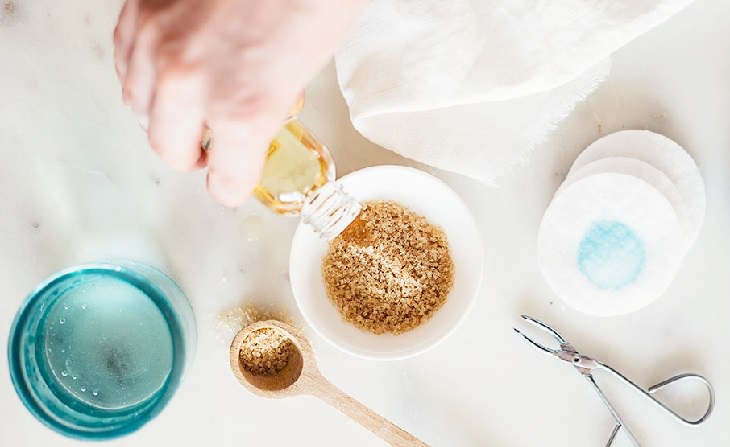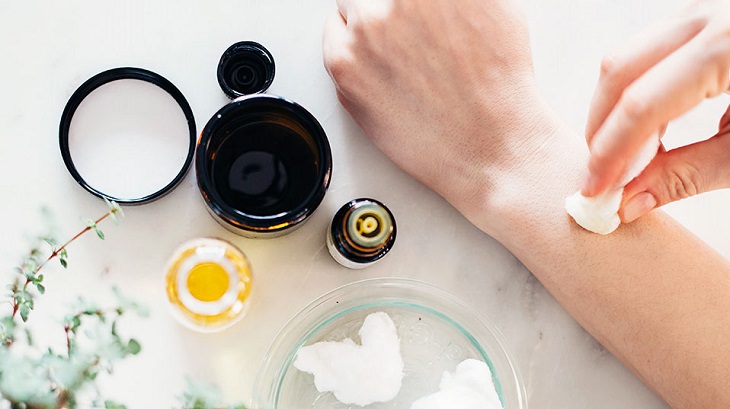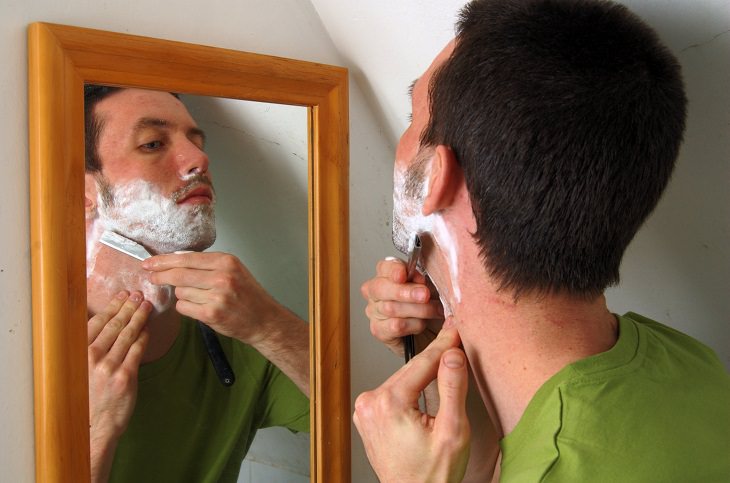1. Properly remove an ingrown hair with sugar and olive oil
The main problem when dealing with ingrown hairs is that many of us cannot resist and start picking at the pimple with tweezers or even with our hands to pull the hair out of place. While it may seem that getting rid of it will speed up the healing process, in reality, we are creating an infection that can leave unpleasant scars on the skin. If you want to remove the hair yourself, here's how to do it effectively without making the situation worse:
Ingredients:
- 2 tablespoons of sugar
- ½ tablespoon of olive oil
- Cloth
- Tweezers
- Disinfecting alcohol
- Hot water
- Coconut oil – optional

Instructions:
1. Soak the tweezers in alcohol to disinfect them, then rinse them with water.
2. To remove dead skin cells that may be blocking the hair’s growth path, mix a little olive oil with sugar until you get a thick paste. Rub the paste in circular motions around the spot where you feel the trapped hair, and then rinse the area with water.
3. Wet the cloth with hot water and place it directly on the skin for 10 minutes. You may need to wet it again to maintain the heat. This step helps to soften the hair and the skin.
4. If you can see the hair, use the clean tweezers to grab it as close to the skin as possible and pull it out. If the hair is still trapped under the skin, continue applying the hot cloth to the area twice a day until it eventually comes out. Don’t be tempted to pull the hair out too early, as this is the quickest way to cause damage.
5. After removal, you can apply a little coconut oil to the area to help the skin heal.
2. Restore smoothness with oatmeal
If you notice small bumps or pimples in the area you shaved, it is most likely a sign of irritation or inflammation. Oatmeal has properties that suppress inflammation and soothe the skin, so it can help your skin return to a smooth and even appearance in a short time.
Ingredients:
- Oatmeal and plain yogurt in a 1:1 ratio, depending on the size of the treated area
- 1 teaspoon of honey
Instructions:
1. Mix the oatmeal and yogurt in a bowl.
2. Add a teaspoon of honey to the mixture and apply it to the affected area.
3. Allow the mixture to dry for about half an hour, then rinse the skin with warm water.
4. Repeat the process twice a day for three days.
3. Prevent clogged follicles with a baking soda paste
If you suffer from an ingrown hair but do not want to pluck it out or notice prominent spots on a large shaved area, such as your legs, you can use the following paste. It will soften your skin, speed up the growth of the hair out of the skin, and prevent its follicle from clogging, as a clogged follicle usually leads to a painful inflammation.
Ingredients:
- 2 teaspoons of baking soda
- A little water
- A gentle moisturizer of your choice

Instructions:
1. Mix baking soda with a little water, just enough to create a paste-like consistency.
2. Wash your hands thoroughly, then apply the paste to the skin in circular motions.
3. Rinse off any residue that wasn’t absorbed by the skin with warm water, and apply a small amount of moisturizer to soften the area.
4. Reduce swelling with honey
Honey, known for its antibacterial properties, can be used to treat painful skin after shaving, reduce swelling and inflammation, and keep the skin rich in moisture. All you need to do is simply apply a thin layer of honey on the irritated skin, let it dry, and then rinse it off with warm water. Alternatively, you can mix one and a half teaspoons of honey with one tablespoon of plain yogurt, apply the mixture to the affected area, wait 15 minutes, and then rinse it off with lukewarm water.
5. Disinfect the area with tea tree oil
Tea tree oil is a wonderful essential oil that helps relieve discomfort and redness of the skin. It has particularly strong antiseptic properties, and in addition to soothing, it also helps fight infections, prevent inflammation in the irritated area, and speed up the healing process if the skin is already damaged. Since it is a potent oil, it is recommended to dilute it with olive oil to avoid irritation or stinging, as demonstrated in the following guide.
Ingredients:
- 2 tablespoons of olive oil
- 15 drops of tea tree oil
- Glass bottle
- Cotton ball

Instructions:
1. Mix the olive oil with tea tree oil thoroughly, and soak a cotton ball in a small amount of the liquid.
2. Press the cotton ball against the skin for a few seconds. You can use a cotton swab if you identify the exact spot.
3. Store the excess in a glass bottle. You can repeat the process twice a day until the condition improves.
6. Reduce razor bumps with cucumber
Cucumber can help reduce razor bumps due to its anti-inflammatory properties and high levels of vitamins C and K. These are known for their healing properties and will help your skin return to a healthy appearance in a short time. Cut a few slices of cucumber, place them in the refrigerator for half an hour, and then gently rub them on the area you shaved (face, legs, underarms, etc.) for 10 minutes.
7. Relieve itching with apple cider vinegar
One of the leading problems associated with post-shaving irritation is the itching and tingling sensation that attacks the skin, making it difficult for many people to avoid touching it, which can lead to infection and inflammation. Apple cider vinegar is attributed to numerous benefits when it comes to maintaining facial skin appearance, thanks to its ability to protect the skin from inflammation and infections and even prevent pimples. It is recommended to try it when dealing with itchy and irritating skin. Use a cotton ball soaked in apple cider vinegar and gently massage the area for a few seconds. If you have particularly sensitive skin, it is recommended to dilute the vinegar with a little warm water and test it on a small area before applying it to a larger area.

8. Prevent redness with black tea bags
Did you make a cup of tea? Use the tea bags to soothe irritated skin after shaving. If you suffer from redness and symptoms characteristic of inflammatory processes, the tannic acid in black tea will help address the issue. This solution is suitable for all skin types and all areas of the body, so there is no reason to fear it or avoid it.
Instructions:
1. Wet a black tea bag with warm water. Allow the bag to cool down, or place it in the refrigerator for 5-10 minutes.
2. Gently massage the bag against the injured area for 2-3 minutes.
3. Repeat the process several times a day as needed.
Prevention tips
The best way to treat the unpleasant side effects of shaving is to minimize their occurrence in the first place. Although there is no solution that will completely prevent them, you can use some tips to help you enjoy a more comfortable shave. Did you pull out a new and clean razor from the package? These are the things you should remember before shaving:
1. Soften the skin – Be sure to regularly use a facial or body moisturizer and don’t rely solely on shaving cream to protect your skin. Softening the skin reduces the chance of hair follicles being blocked by dead skin cells, so they don’t have to grow sideways and cause irritation. At the same time, softer skin allows for a smoother shave, preventing cuts or injuries. You can also use a scrub every few weeks to effectively remove the layer of dead skin cells.







